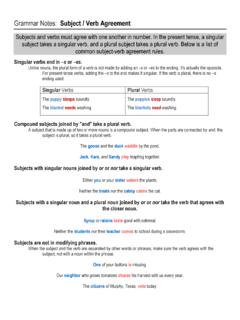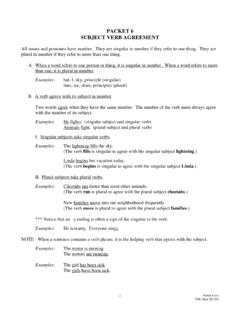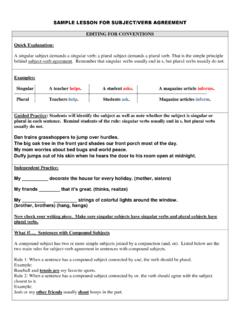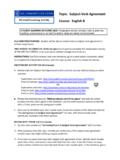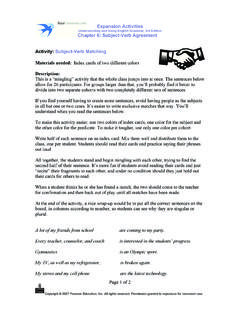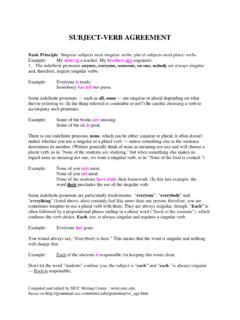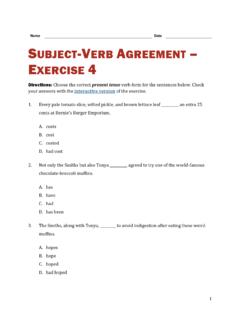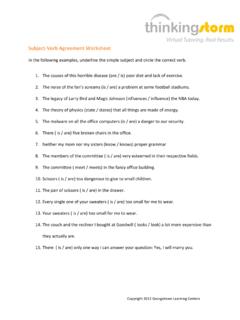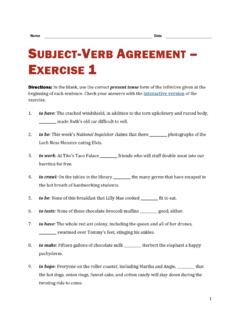Transcription of 2015 SAT Writing Test - serragotestprep.com
1 Copyright 2015 by Sharon Serrago, Inc Page 143 subject - verb agreement Copyright 2015 by Sharon Serrago, Inc Page 144 subject - verb agreement is one of the areas you have surely studied in your English classes. As you have seen, there are many rules governing the usage of subjects and verbs. We will cover several of them here. The first thing you must know is that the subject of the sentence and the verb of the sentence must agree in number.
2 If the subject is plural, then the verb must be plural also. If the subject is singular, then the verb must be singular also. Whatever the subject is, the verb must be the same. That s why we call it agreement . The subject and verb must agree with each other in number. Perhaps the most critical thing for you to know is that all singular verbs end in s .. with the exception of I am and you are. Look at these verbs: is, are, do, does, seem, seems, ask, asks, was, were. The ones that end in s are all singular: is, does, seems, asks, was. Look at all the following verbs and label each as singular or plural.
3 1. was _____ 4. is _____ 2. look _____ 5. were _____ 3. thinks _____ 6. ask _____ Now let s look at some simple sentences and you decide which verb must agree with the subject . Follow these steps. 1. Decide upon the subject . 2. Determine whether it is singular or plural. 3. Choose the verb form that is the same as the subject , singular or plural. 1. That man (is, are) the one who painted our house last summer. 2. Those children (was, were) arranged according to height. 3. James (asks, ask) a lot of questions because he is anxious to learn.
4 4. All our geese (swims, swim) in the pond adjacent to our property. 5. Some boys (runs, run) much faster than others. 6. Our vacation (lasts, last) for three weeks this year. 7. Sam (want, wants) to know the results of the test last week. 8. Each one (has, have) his own idea about how the outcome should be. 9. Everything (was, were) laid out on the table in preparation for the meal. 10. The cars (was, were) about to be washed by the school s club. subject - verb agreement agreement of Subjects and Verbs Copyright 2015 by Sharon Serrago, Inc Page 145 Trying to be sure the subject and the verb agree may seem like a simple task, but for many students the task becomes complicated because of the difficulty in actually identifying the subject in the first place.
5 It s easy enough to make the subject and verb agree you are looking at a very simple sentence, but in a complicated sentence structure like you will find on the SAT, finding the subject is not such an easy task at all. There are some ways to make that task easier. First, you should eliminate constructions in the sentences that you know can t be the subject . One of the things we can eliminate is the prepositional phrase. There may be several of them in one sentence. In fact, the more sophisticated the sentence, the more propositional phrases the sentence is likely to have.
6 Once you eliminate all prepositional phrases, finding the subject will be much easier. Let s review what you already know about prepositions, and then we will move on to prepositional phrases. A preposition is a word that shows a relationship to another word in the sentence. Many prepositions show a spatial relationship to another word. Take a look at this cat and the tree. Any position the cat can have in relation to the tree is going to be a preposition. For instance, the cat can be beside the tree, in the tree, on the tree. Look at the prepositions that can express a spatial relationship: over, above, under, underneath, between, by, beneath, to, from.
7 He can go up, down, into, out, through, across, along, around, beneath, beside, behind the tree. These are only a few prepositions. There are others such as like, with, without, to, about, after, during, following, concerning, regarding, aboard, against, amid among, around, at, before, below, beyond, but, considering, despite, except, excluding, for, of, inside, near, off, onto, outside, past, per, plus, round, save, since, toward, unlike, upon, versus, via, within. We also have a compound prepositions, two or more words commonly used as a single preposition: on top of, according to, along with, apart from, by virtue of, due to, except for, in addition to, in between, out of.
8 There are more, but you will be able to recognize them. 1. He ran on the sidewalk. 2. The child jumped into the hole. 3. Before class, the children walked slowly down the hall. 4. Beside the road lay the old cart. 5. The cat sat on the shelf above the door. 6. Into the room they calmly strolled. 7. Under no circumstances are you to touch that glass sitting on the table. 8. He saw the book on top of the desk in his friend s room. 9. We built the tree house for the child. 10. With a big crash, the tree toppled onto the garage.
9 Let s Practice Finding Prepositions Underline the prepositions in the following sentences. Subjects and Prepositional Phrases Copyright 2015 by Sharon Serrago, Inc Page 146 Next, we need to learn how to identify prepositional phrases so that we can eliminate them and make it easier to find the subject of the sentence. It is important to know that every preposition must have an object. Many students confuse the object of the preposition with the subject . When you eliminate the whole phrase, this will not happen to you.
10 The object of the preposition is the first noun after the preposition. The two words together constitute a prepositional phrase. The prepositional phrase begins with the preposition, ends with the 1st noun after it, and includes all words (adjectives and adverbs only) in between. Example: The dog with the dirt on his face ran through the puddle in the middle of the road. These are the prepositional phrases: with the dirt on his face through the puddle in the middle of the road The nouns in the phrases are the objects of the prepositions: dirt face puddle middle road In each phrase, the first noun after the preposition is the object of the preposition.
